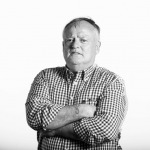THAT’S MY WATER!
Power and Water Corporation, which has about 51,000 customers spread across an area more than five times the size of Victoria, delivers essential services despite facing some of the most extraordinary challenges of any utility in the world.


The terrain, widespread and diverse customer base, and water source challenges are compounded by the fact Territorians are Australia’s heaviest water users – 57 percent goes on gardens and 12 percent is lost through leaks.
Manager Water Demand Jethro Laidlaw believes the heavy use is often due to a perception among some people that water is unlimited. “Most people don’t really think about where their water actually comes from or how we get it to their taps,” he says. “People protect other water sources, such as rivers and lakes, but don’t have the same attitudes towards water when it comes out of a tap.”
To help educate the community, Power and Water has honed in to empower an influential cohort – Northern Territory school students. The utility has teamed up with Yolngu rapper and 2019 Young Australian of the Year Baker Boy to produce a series of videos about the sustainable use of water called ‘That’s My Water!’
The videos demonstrate the importance of water in traditional culture, through Aboriginal elders from Larrakia, Jawoyn and Arrernte nations explaining their relationship to water, how water gets treated from the cloud to the cup, and steps children and families can take to ensure the longevity of our water supply.
“I hope these videos can inspire the kids to take control of their environment,” Baker Boy says. “We can’t live on country without water and we need our next gen to learn how to take care of it and not waste it. “Learning where water comes from and how the whole water process works empowers our youth with knowledge.”
Baker Boy, who grew up in the Arnhem Land communities of Maningrida and Milingimbi, wants to use the videos to inspire students to learn about where their water comes from and about Aboriginal cultural connection to water. Mr Laidlaw is delighted to team up with such a respected young Aboriginal role model.
“We hope having him as the face of our program will encourage young people to save water where they can,” he says. “Water is a precious resource, and this program is about empowering young Territorians to take ownership over and respect this resource. “We want the next generation to understand where their water comes from and the very important role they have in making sure water continues to flow from the taps.
“In remote communities, preserving water helps allow people to continue to live on country, and in the major centres it is no different – we all need to start to value tap water more.”
A series of three ‘That’s My Water!’ videos have been made – covering traditional water knowledge, water supply and what kids can do to save water. The videos can be viewed at powerwater.com.au/thatsmywater
The videos form part of a broader water use education kit, which includes student workbooks and a parent, helper or teacher guide. The resources are matched to the Australian curriculum and are designed to be flexible enough so that they can be delivered over just one lesson right up to a whole term.
The new campaign builds on the work the water demand team has done over the years with the NT Departments of Education, as well as Environment and Natural Resources, Charles Darwin University and the Bureau of Meteorology. Through these partnerships, the Power and Water team have worked with more than 2500 students at schools over the past four years.
The curriculum unit has been successful in introducing students to the idea of the water cycle and thinking about how water is treated and transported to their taps, while drawing strongly on the STEM subjects – science, technology, engineering and mathematics. This year, Power and Water is branching out across the Territory to develop students’ practical knowledge and skills as well as empowering them to take action in their community.
The team’s work in the water demand management space continues to grow from strength to strength, thanks to the utility’s Living Water Smart program, which has been operating in Darwin and Katherine, and long-running efforts in many remote communities. The message is starting to get through – water use in Darwin and Katherine has fallen by 20 percent over the past five years and many remote communities have reduced their water use by more than 40 percent.
Meanwhile, Engawala, which is north of Alice Springs, now uses less water per person than any other town in the Territory. “Demand management works,” says Mr Laidlaw.
“We spend less on reducing demand than we do trying to find or in building new water sources. “It prolongs the life of water sources by years and helps customers reduce their bills through developing an understanding of the value of water.” TQ

